Research News & Highlights
UKI Discs Meeting 2024 to be hosted at the University of Warwick
Our discs group recently started the UK & Ireland (UKI) Discs community, where we aim to bring together the disc communities across the UK & Ireland for those working on astrophysical discs on various scales, from circumplanetary to galactic discs. We are excited to announce the first UKI Discs Meeting will be hosted at the University of Warwick from the 9th - 11th of September 2024 and will focus on protoplanetary discs and debris discs (including white dwarf discs). To register and find out more, follow the link hereLink opens in a new window.
The abstract submission deadline for talks/posters is the 12th of May 2024.

ALMA and Keck analysis of Fomalhaut field sources: JWST's Great Dust Cloud is a background object
Grant M. Kennedy, Joshua B. Lovell, Paul Kalas, Michael P. Fitzgerald
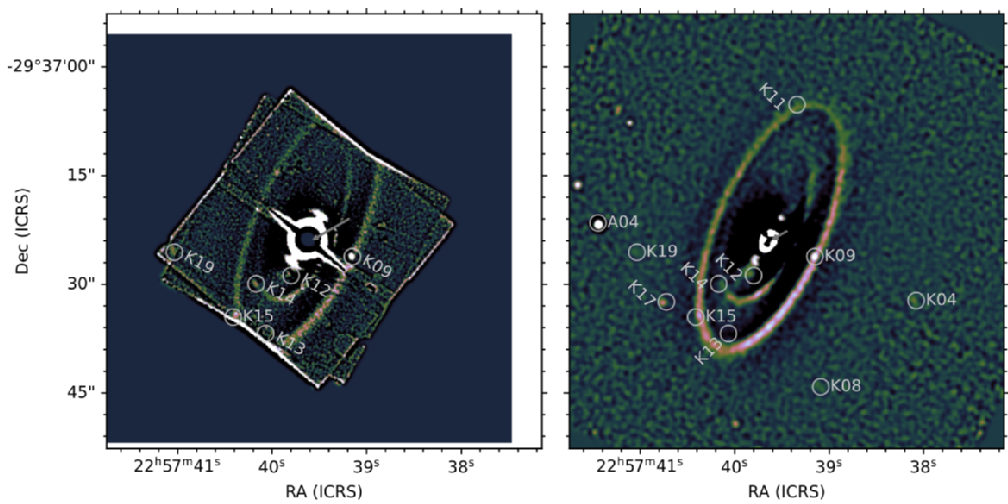
At 7.7 pc, the A-type star Fomalhaut hosts a bright debris disk with multiple radial components. The disk is eccentric and misaligned, strongly suggesting that it is sculpted by interaction with one or more planets. Compact sources are now being detected with JWST, suggesting that new planet detections may be imminent. However, to confirm such sources as companions, common proper motion with the star must be established, as with unprecedented sensitivity comes a high probability that planet candidates are actually background objects. Here, ALMA and Keck observations of Fomalhaut are found to show significant emission at the same sky location as multiple compact sources in JWST MIRI coronagraphic observations, one of which has been dubbed the "Great Dust Cloud" because it lies within the outer belt. Since the ground-based data were obtained between 6 to 18 years prior to the JWST observations, these compact sources are unlikely to be common proper motion companions to Fomalhaut. More generally, this work illustrates that images collected at a range of wavelengths can be valuable for rejecting planet candidates uncovered via direct imaging with JWST.
Planetesimals drifting through dusty and gaseous white dwarf debris discs: Types I, II and III-like migration
Dimitri Veras, Shigeru Ida, Evgeni Grishin, Scott J. Kenyon, Benjamin C. Bromley
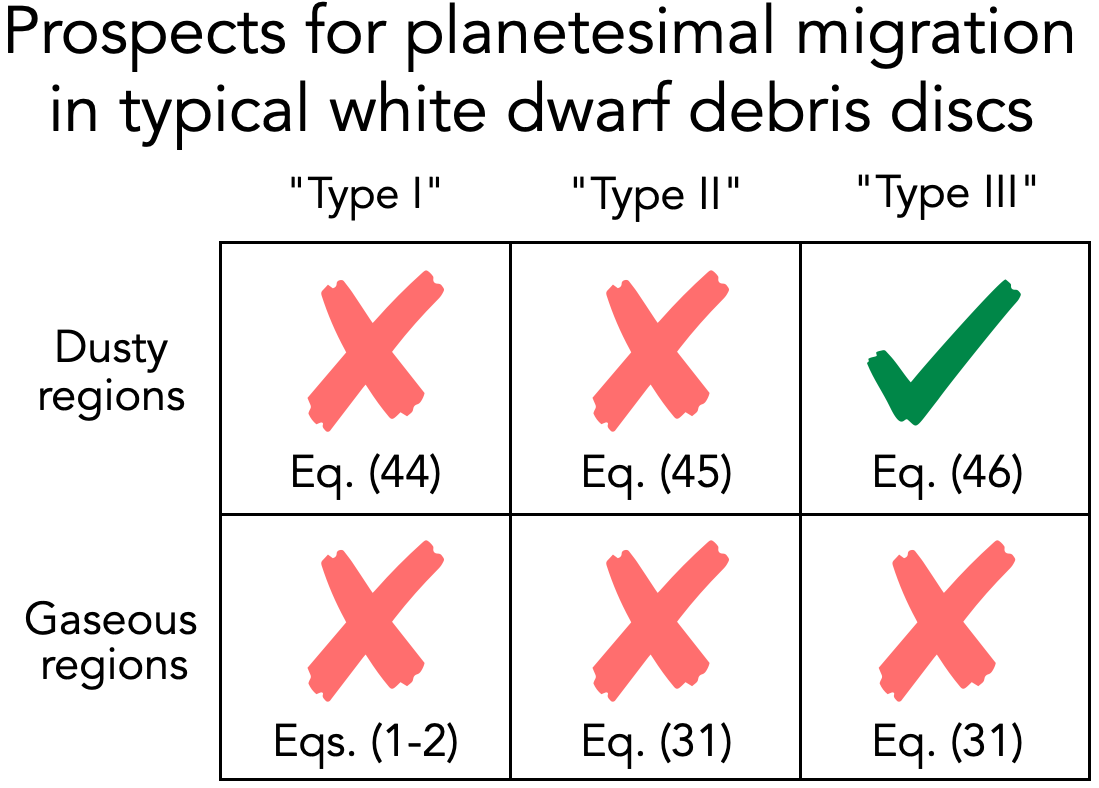
The suite of over 60 known planetary debris discs which orbit white dwarfs, along with detections of multiple minor planets in these systems, motivate investigations about the migration properties of planetesimals embedded within the discs. Here, we determine whether any of the migration regimes which are common in (pre-)main-sequence protoplanetary discs, debris discs and ring systems could be active and important in white dwarf discs. We investigate both dust-dominated and gas-dominated regions, and quantitatively demonstrate that Type I and Type II migration, as well as their particulate disc analogues, are too slow to be relevant in white dwarf discs. However, we find that the analogue of Type III migration for particulate discs may be rapid in the dusty regions of asteroid- or moon-generated (>1018 kg) white dwarf discs, where a planetesimal exterior to its Roche radius may migrate across the entire disc within its lifetime. This result holds over a wide range of disc boundaries, both within and exterior to 1R⊙, and such that the probability of migration occurring increases with higher disc masses.
Evolving extrasolar Kirkwood gaps
Dimitri Veras, Nikolaos Georgakarakos, Ian Dobbs-Dixon
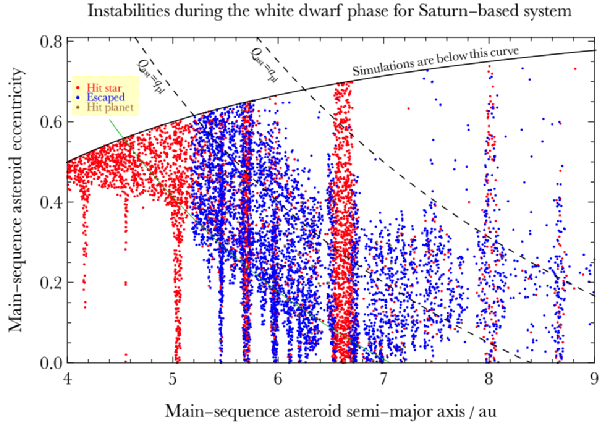
The evolution of planetary debris discs, such as extrasolar analogues of the solar system's Main Belt and Kuiper Belt, crucially determine how host stars are polluted with planetary metals. This new paper presents high-resolution resonant portraits of these debris discs as they evolve beyond the main-sequence and interact with a surviving planet in the system. We find that evolving resonant structure can be accurately bound with only main-sequence values by computing a maximum libration width as a function of asteroid longitude of pericentre. We also quantify the relative efficiency of mean motion resonances of different orders to stabilize versus destabilize asteroid orbits during both the giant branch and white dwarf phases. The 4:1, 3:1 and 2:1 resonances represent efficient polluters of white dwarfs, and even when in the orbit-crossing regime, both the 4:3 and 3:2 resonances can retain small reservoirs of asteroids in stable orbits throughout giant branch and white dwarf evolution.
Debris Discs: Home and Abroad 2022
Raphael Bendahan-West -- Automated Search for Spectroscopic Exocomet Transits
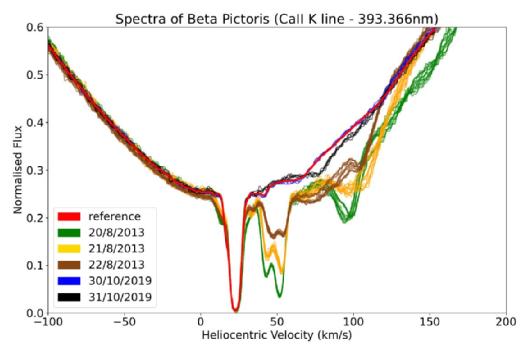
Exocomets are analogues of solar system comets, with the main difference being that they orbit stars other than the Sun. These extrasolar comets can be thought of as small icy planetesimals that were left unused during the planet formation phase of a system. Although being “leftover” dust agglomerates, exocomets tend to be part of the most pristine objects in a system, enclosing primordial information about the early phases of planetary formation.
The field of exocomets has been built around the unmatched number of detections made in the circumstellar disc of the archetypal star Beta Pictoris. An exocomet detection is identified by variable absorption features around atomic lines in a stellar spectrum (typically around the ionised Calcium doublet), which can be explained by the interaction between the light emitted by a star and the transiting gas that is in and trailing an exocomet coma. Variability in the CaII doublet has been observed around approximately 30 different stars – certain detections being clearer than others, emphasising the rarity and difficulty to observe such events.
In this talk, I will show results from an automated search through the HARPS archive for signs of exocomet transits. Such a spectroscopic survey is unprecedented mainly due to the large quantity and wide variety of stars being observed. This talk will introduce our newly developed automated search algorithm that quantifies the rate of CaII exocomet absorption events in archival spectra, with the goal to estimate the occurrence rate of transiting exocomets.
Azib Norazman -- An Automated Search for Transiting Exocomets with TESS
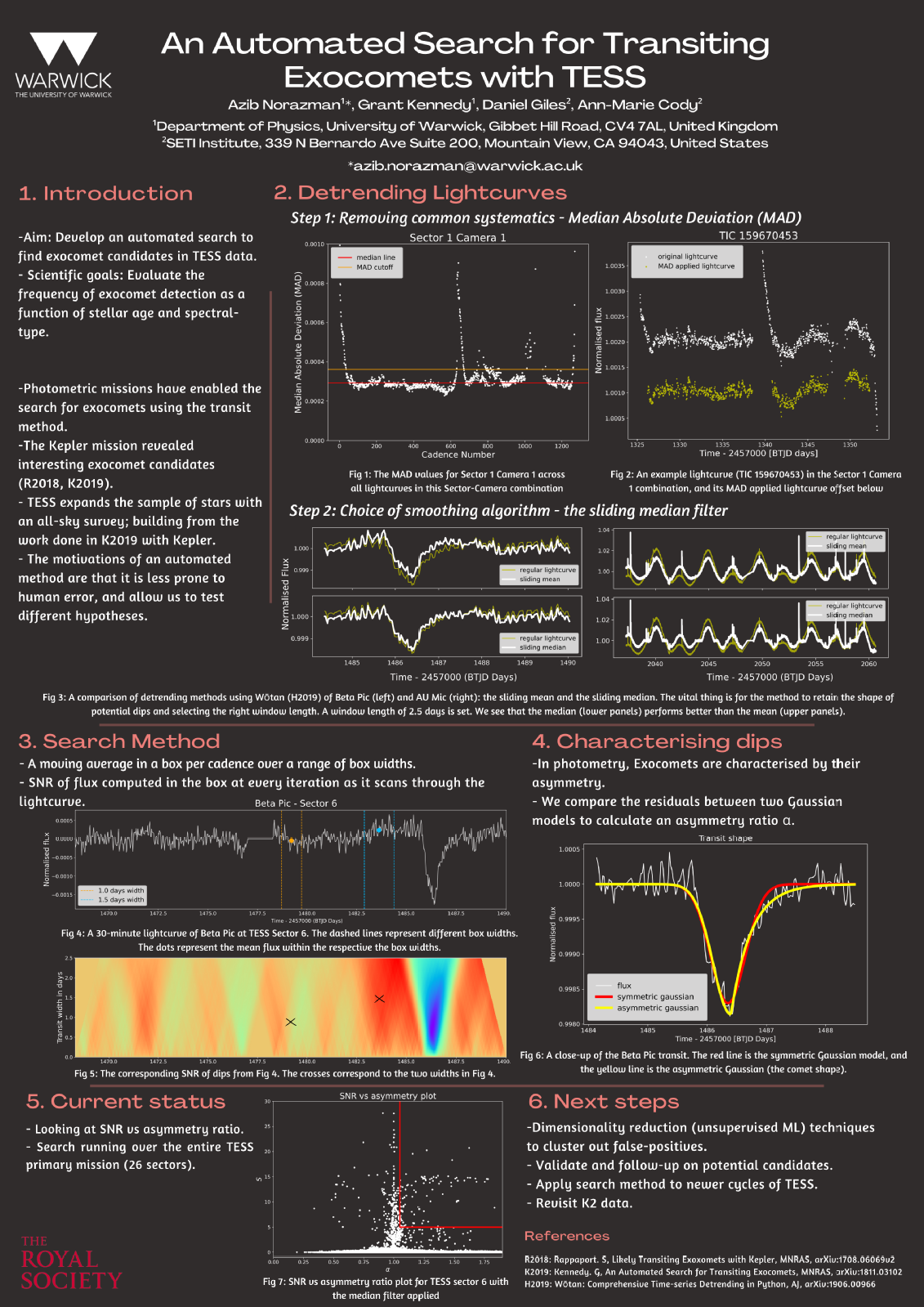
The term exocomets refers to analogues of our Solar System comets. They are small icy planetesimal bodies that orbit stars other than the Sun and are thought to be the remnants of exoplanet formation. In recent years, there have been a small number of stars that have unique asymmetric dips in their transits from photometric data that cannot be caused by a planet transit. The most prominent example of this so far are from the lightcurves of Beta Pictoris, a young A-type star. Recent literature has also indicated that exocomet detections are more likely in younger, A/F-type stars. As the TESS mission carries out an all-sky survey, there is now the opportunity to explore this hypothesis further and explore the detection rates of exocomets with relation to the spectral type of their host star- uncovering the occurrence rates as a function of spectral type and stellar age. A simple automated method to detect exocomet transits was developed for the Kepler mission. As TESS expands the sample of stars over the whole sky, a plethora of star systems will be explored. However, the nature of the all-sky search results in a wide range of astrophysical variability in addition to the different systematics the spacecraft has compared to Kepler. Therefore, development of the search method for TESS is essential. We present the automated search algorithm used to find potential asymmetric transit dips in TESS, and the results of my search at the time of the conference.
ALMA's view of the M-dwarf GSC 07396-00759's edge-on debris disc: AU Mic's coeval twin
Patrick F. Cronin-Coltsmann, Grant M. Kennedy, Christian Adam, Quentin Kral, Jean-François Lestrade, Sebastian Marino, Luca Matrà, Simon J. Murphy, Johan Olofsson, Mark C. Wyatt
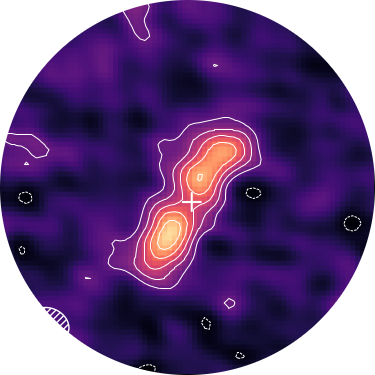
We present new ALMA Band 7 observations of the edge-on debris disc around the M1V star GSC 07396-00759. At ~20 Myr old and in the beta Pictoris Moving Group along with AU Mic, GSC 07396-00759 joins it in the handful of low mass M-dwarf discs to be resolved in the sub-mm. With previous VLT/SPHERE scattered light observations we present a multi-wavelength view of the dust distribution within the system under the effects of stellar wind forces. We find the mm dust grains to be well described by a Gaussian torus at 70 au with a FWHM of 48 au and we do not detect the presence of CO in the system. Our ALMA model radius is significantly smaller than the radius derived from polarimetric scattered light observations, implying complex behaviour in the scattering phase function. The brightness asymmetry in the disc observed in scattered light is not recovered in the ALMA observations, implying that the physical mechanism only affects smaller grain sizes. High resolution follow-up observations of the system would allow investigation into its unique dust features as well as provide a true coeval comparison for its smaller sibling AU Mic, singularly well observed amongst M-dwarfs systems.
ALMA imaging of the M-dwarf Fomalhaut C's debris disc
Patrick F. Cronin-Coltsmann, Grant M. Kennedy, Paul Kalas, Julien Milli, Cathie J. Clarke, Gaspard Duchêne, Jane Greaves, Samantha M. Lawler, Jean-François Lestrade, Brenda C. Matthews, Andrew Shannon, Mark C. Wyatt
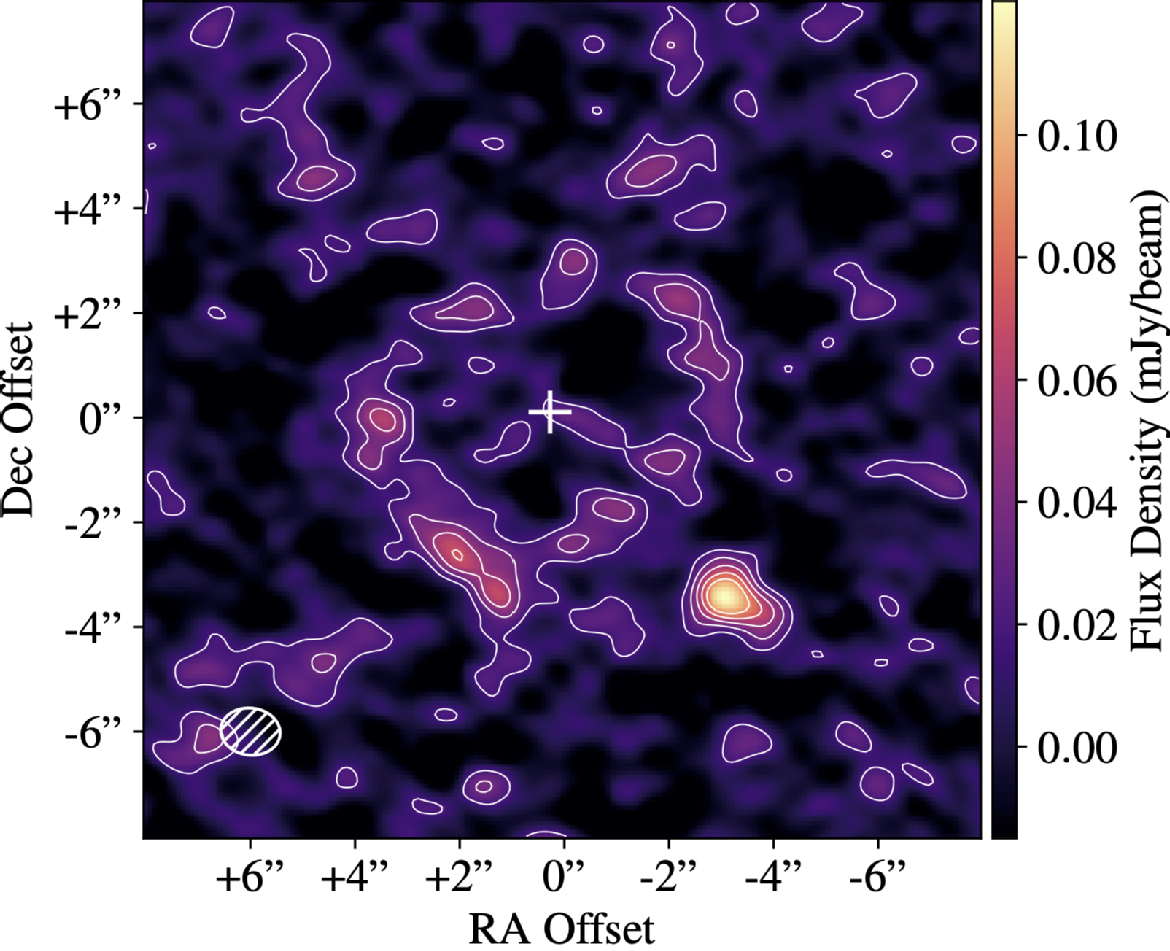
Fomalhaut C (LP 876-10) is a low mass M4V star in the intriguing Fomalhaut triple system and, like Fomalhaut A, possesses a debris disc. It is one of very few nearby M-dwarfs known to host a debris disc and of these has by far the lowest stellar mass. We present new resolved observations of the debris disc around Fomalhaut C with the Atacama Large Millimetre Array which allow us to model its properties and investigate the system's unique history. The ring has a radius of 26 au and a narrow full width at half maximum of at most 4.2 au. We find a 3σ upper limit on the eccentricity of 0.14, neither confirming nor ruling out previous dynamic interactions with Fomalhaut A that could have affected Fomalhaut C's disc. We detect no 12CO J=3-2 emission in the system and do not detect the disc in scattered light with HST/STIS or VLT/SPHERE. We find the original Herschel detection to be consistent with our ALMA model's radial size. We place the disc in the context of the wider debris disc population and find that its radius is as expected from previous disc radius-host luminosity trends. Higher signal-to-noise observations of the system would be required to further constrain the disc properties and provide further insight to the history of the Fomalhaut triple system as a whole.
